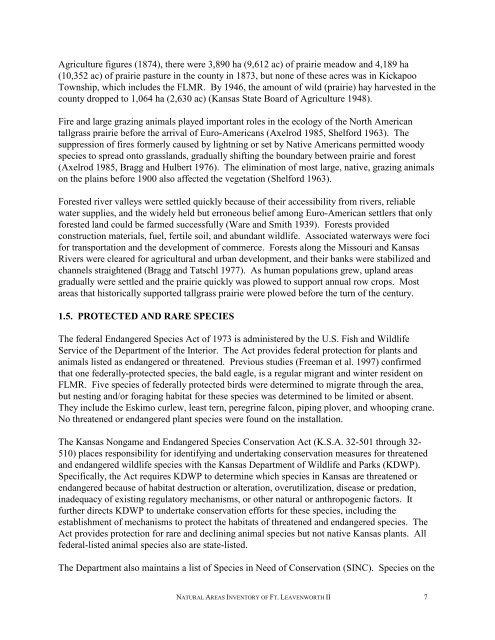A Natural Areas Inventory of the - Kansas Natural Heritage Inventory ...
A Natural Areas Inventory of the - Kansas Natural Heritage Inventory ...
A Natural Areas Inventory of the - Kansas Natural Heritage Inventory ...
Create successful ePaper yourself
Turn your PDF publications into a flip-book with our unique Google optimized e-Paper software.
Agriculture figures (1874), <strong>the</strong>re were 3,890 ha (9,612 ac) <strong>of</strong> prairie meadow and 4,189 ha<br />
(10,352 ac) <strong>of</strong> prairie pasture in <strong>the</strong> county in 1873, but none <strong>of</strong> <strong>the</strong>se acres was in Kickapoo<br />
Township, which includes <strong>the</strong> FLMR. By 1946, <strong>the</strong> amount <strong>of</strong> wild (prairie) hay harvested in <strong>the</strong><br />
county dropped to 1,064 ha (2,630 ac) (<strong>Kansas</strong> State Board <strong>of</strong> Agriculture 1948).<br />
Fire and large grazing animals played important roles in <strong>the</strong> ecology <strong>of</strong> <strong>the</strong> North American<br />
tallgrass prairie before <strong>the</strong> arrival <strong>of</strong> Euro-Americans (Axelrod 1985, Shelford 1963). The<br />
suppression <strong>of</strong> fires formerly caused by lightning or set by Native Americans permitted woody<br />
species to spread onto grasslands, gradually shifting <strong>the</strong> boundary between prairie and forest<br />
(Axelrod 1985, Bragg and Hulbert 1976). The elimination <strong>of</strong> most large, native, grazing animals<br />
on <strong>the</strong> plains before 1900 also affected <strong>the</strong> vegetation (Shelford 1963).<br />
Forested river valleys were settled quickly because <strong>of</strong> <strong>the</strong>ir accessibility from rivers, reliable<br />
water supplies, and <strong>the</strong> widely held but erroneous belief among Euro-American settlers that only<br />
forested land could be farmed successfully (Ware and Smith 1939). Forests provided<br />
construction materials, fuel, fertile soil, and abundant wildlife. Associated waterways were foci<br />
for transportation and <strong>the</strong> development <strong>of</strong> commerce. Forests along <strong>the</strong> Missouri and <strong>Kansas</strong><br />
Rivers were cleared for agricultural and urban development, and <strong>the</strong>ir banks were stabilized and<br />
channels straightened (Bragg and Tatschl 1977). As human populations grew, upland areas<br />
gradually were settled and <strong>the</strong> prairie quickly was plowed to support annual row crops. Most<br />
areas that historically supported tallgrass prairie were plowed before <strong>the</strong> turn <strong>of</strong> <strong>the</strong> century.<br />
1.5. PROTECTED AND RARE SPECIES<br />
The federal Endangered Species Act <strong>of</strong> 1973 is administered by <strong>the</strong> U.S. Fish and Wildlife<br />
Service <strong>of</strong> <strong>the</strong> Department <strong>of</strong> <strong>the</strong> Interior. The Act provides federal protection for plants and<br />
animals listed as endangered or threatened. Previous studies (Freeman et al. 1997) confirmed<br />
that one federally-protected species, <strong>the</strong> bald eagle, is a regular migrant and winter resident on<br />
FLMR. Five species <strong>of</strong> federally protected birds were determined to migrate through <strong>the</strong> area,<br />
but nesting and/or foraging habitat for <strong>the</strong>se species was determined to be limited or absent.<br />
They include <strong>the</strong> Eskimo curlew, least tern, peregrine falcon, piping plover, and whooping crane.<br />
No threatened or endangered plant species were found on <strong>the</strong> installation.<br />
The <strong>Kansas</strong> Nongame and Endangered Species Conservation Act (K.S.A. 32-501 through 32-<br />
510) places responsibility for identifying and undertaking conservation measures for threatened<br />
and endangered wildlife species with <strong>the</strong> <strong>Kansas</strong> Department <strong>of</strong> Wildlife and Parks (KDWP).<br />
Specifically, <strong>the</strong> Act requires KDWP to determine which species in <strong>Kansas</strong> are threatened or<br />
endangered because <strong>of</strong> habitat destruction or alteration, overutilization, disease or predation,<br />
inadequacy <strong>of</strong> existing regulatory mechanisms, or o<strong>the</strong>r natural or anthropogenic factors. It<br />
fur<strong>the</strong>r directs KDWP to undertake conservation efforts for <strong>the</strong>se species, including <strong>the</strong><br />
establishment <strong>of</strong> mechanisms to protect <strong>the</strong> habitats <strong>of</strong> threatened and endangered species. The<br />
Act provides protection for rare and declining animal species but not native <strong>Kansas</strong> plants. All<br />
federal-listed animal species also are state-listed.<br />
The Department also maintains a list <strong>of</strong> Species in Need <strong>of</strong> Conservation (SINC). Species on <strong>the</strong><br />
NATURAL AREAS INVENTORY OF FT. LEAVENWORTH II 7


